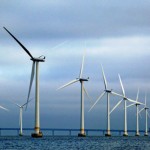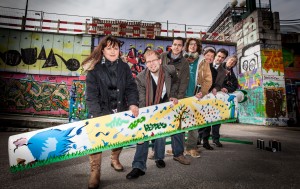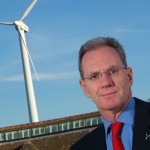 In an editorial published by Recharge, Morten Albæk, Senior Vice-President of marketing at Vestas, argues that claims made by anti-wind campaigners can verge on the ridiculous, but they are powerful. Wind power, meanwhile, is not doing enough to promote its positive message…
In an editorial published by Recharge, Morten Albæk, Senior Vice-President of marketing at Vestas, argues that claims made by anti-wind campaigners can verge on the ridiculous, but they are powerful. Wind power, meanwhile, is not doing enough to promote its positive message…
Birds are 19,200 times more likely to die from flying into a building than into a wind turbine (according to the US Forest Service.) So calling wind turbines devastating to wildlife is equivalent to describing ordinary houses as mass killing machines. Ironically, 10% of all bird species are threatened by climate change (according to the International Union for the Conservation of Nature.)
Unfortunately, this is a well-kept secret. Not least due to our industry’s failure to adequately convey even the most appealing truths to the public.
Public and political support for wind energy is being increasingly eroded by media-savvy and politically influential groups that often demonstrate a brazen disregard for fact-based information. This is a growing business risk. continue reading »
 Headlines in the German media have said recently that Germany’s offshore wind sector could be facing support cuts, on top of suffering from the already costly grid connection delays. So what is the future of German offshore wind power? We spoke to Andreas Wagner, CEO of the Offshore Wind Foundation (Stiftung Offshore-Windenergie) and part of the team negotiating with German Chancellor Angela Merkel to try and find out…
Headlines in the German media have said recently that Germany’s offshore wind sector could be facing support cuts, on top of suffering from the already costly grid connection delays. So what is the future of German offshore wind power? We spoke to Andreas Wagner, CEO of the Offshore Wind Foundation (Stiftung Offshore-Windenergie) and part of the team negotiating with German Chancellor Angela Merkel to try and find out…
EWEA Germany’s Environment Minister Peter Altmaier has proposed to substantially change the law for financial support for renewable energy in Germany. Could the offshore wind industry be affected by the same retroactive changes we’ve seen in other EU countries?
Wagner On 21 March, Chancellor Angela Merkel discussed all options to change the EEG-law [the current law supporting renewable energy – ed] with the Prime Ministers of the 16 German Länder. As a result of this so-called ‘energy summit’, we will definitely not face retroactive changes for projects for which legally binding contracts have been signed. I doubt if other changes in the EEG will or can be made before the German federal elections in September.
EWEA What were the arguments raised with Chancellor Merkel? continue reading »
 With Global Wind Day just over two months away, the Austrian Wind Energy Association has decided to place a mini wind turbine right in the centre of Vienna. Lukas Pawek, coordinator of Global Wind Day in Austria, explains why…
With Global Wind Day just over two months away, the Austrian Wind Energy Association has decided to place a mini wind turbine right in the centre of Vienna. Lukas Pawek, coordinator of Global Wind Day in Austria, explains why…
This week the Austrian Wind Energy Association placed a small wind turbine in the centre of Vienna adorned in art by local graffiti artist Tim Stehle. This event is the official start of the first “Austrian Wind Art Contest”, aiming at promoting Global Wind Day on 15 June. It’s easy to join the contest: just upload a picture before 15 August of your wind art at: www.tagdeswindes.at/kunst, and you could win one of nine prizes from an electric bike to an Apple iPad. A jury of art-cooperatives and wind power companies will select and award the prizes.
continue reading »

Mike Anderson
Estimating how much energy a planned wind farm will produce – the so-called resource assessment – with as much accuracy as possible is vital to gaining financing for that project, but forecasting energy output is fraught with difficulty. We spoke to Mike Anderson, Technical Director at RES, to unpick the issues.
What exactly is resource assessment?
Resource assessment is all about working out how much energy a site selected for a wind farm will produce. It is the process of using available climatological and topographical data to calculate, with minimised uncertainty, the potential energy produced within a site considered for development. The process of undertaking a resource assessment is complex and involves skill and judgement coupled with a firm understanding of numerical models.
Why is it important and who is interested in it?
The economics of a wind farm project are crucially dependent on the wind resource at a site. A robust estimate of the energy production of a prospective wind farm based on a wind and energy assessment is essential in supporting investment and financing decisions for both developers and investors. The more accurate the resource assessment, the more trust financiers will have in wind energy and therefore the greater the likelihood is of gaining finance for a project. Conversely, if assessments made by wind farm project developers differ greatly from the reality, financiers are likely to ask questions. That is why it’s important to work together as an industry to try and improve resource assessment as much as we can – essentially good techniques can improve our access to finance. In June EWEA is holding a technology workshop tasked with delving deeper in to resource assessment, if you’d like to know more, click here.
continue reading »

Angelika Pullen
By Angelika Pullen, WindMade
It was predictable, but still disappointing: The Doha climate negotiations confirmed that the multilateral process to save our climate has stalled. We are not likely to see much movement from governments for many years to come.
Unfortunately, though, the climate can’t wait for international negotiators to get their acts together. So, what can we do?
For our sector, it means that we have to press on with the renewable energy revolution regardless. Of course this will continue to be driven by national and regional targets and legislation, but I am convinced that companies and consumers can and must also make a contribution to drive demand for renewable energy.
People want to see change now, with or without a global deal – not just the increasing number of climate activists, but also your average man on the street. Poll after poll shows that people care, that they love renewables, and that they want to have a choice. It’s all about transparency.
continue reading »
 In an editorial published by Recharge, Morten Albæk, Senior Vice-President of marketing at Vestas, argues that claims made by anti-wind campaigners can verge on the ridiculous, but they are powerful. Wind power, meanwhile, is not doing enough to promote its positive message…
In an editorial published by Recharge, Morten Albæk, Senior Vice-President of marketing at Vestas, argues that claims made by anti-wind campaigners can verge on the ridiculous, but they are powerful. Wind power, meanwhile, is not doing enough to promote its positive message…









